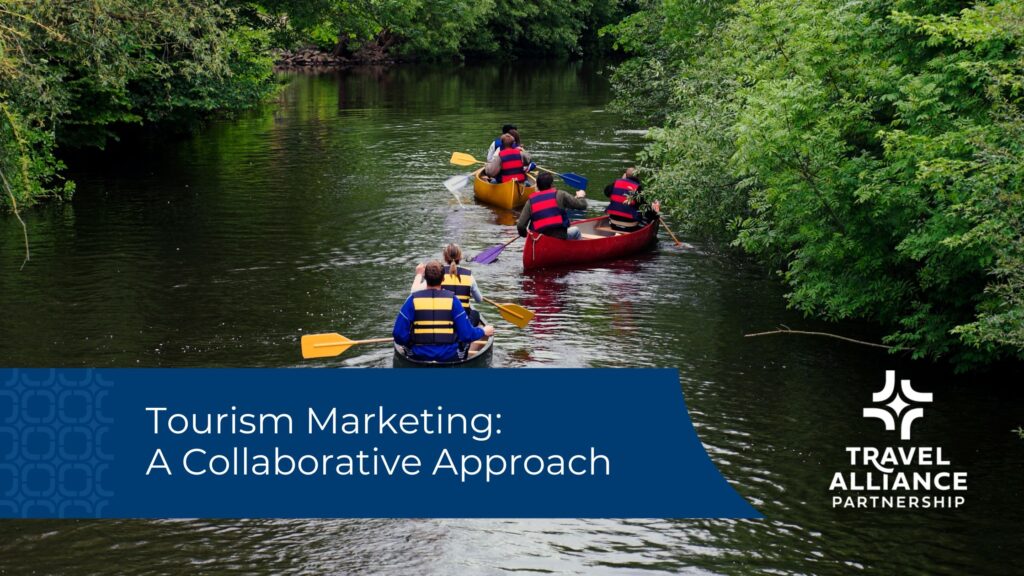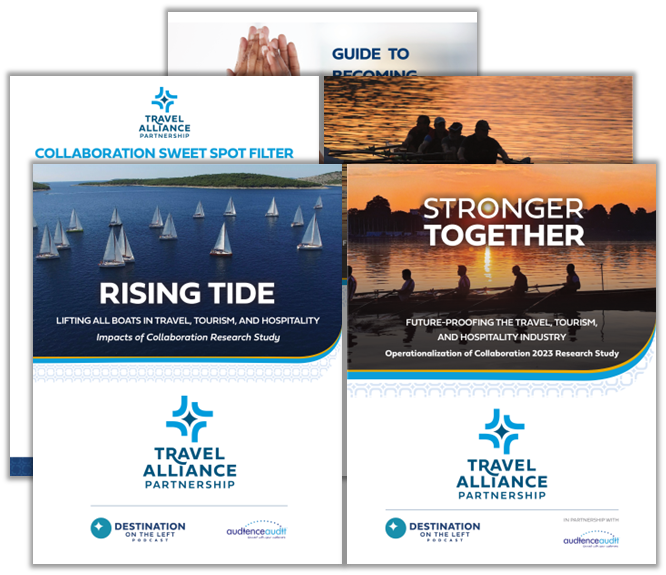Tourism Marketing: A Collaborative Approach
Promoting a destination involves celebrating its unique attractions, culture, and experiences. But when different regions join forces, they create something more powerful together than they could on their own. By working as a team, they draw more visitors, offer amazing experiences, and achieve greater success. This is the power of a collaborative approach in tourism marketing.

Why Collaboration Matters in Tourism
Travelers today are drawn to experiences rather than just sights. According to the U.S. Travel Association, domestic and international visitors spent $1.3 trillion in the U.S. in 2024. People are looking for immersive journeys that connect them to a place, making it critical for tourism organizations to think beyond their individual borders.
Borders between towns or counties don’t matter to travelers. They care about the overall feel of their trip, and how each experience adds to it. That’s where collaboration comes in. When destinations pool their resources, ideas, and marketing efforts, they amplify their appeal. It’s not just about drawing tourists to one attraction but curating a holistic itinerary that keeps them engaged and coming back for more.
Research supports this approach. According to our Rising Tide Study, 99% of respondents in the travel, tourism, and hospitality industry have collaborated with other organizations. Whether this means creating itineraries that span regions or joining forces on marketing campaigns, one thing is clear: partnerships help to attract travelers, meet their expectations, and strengthen the industry.
The Benefits of a Collaborative Approach
Working together takes effort, but the perks are worth it. Here’s why collaboration in tourism works so well:
Better Travel Experiences
When destinations join forces, they can offer visitors comprehensive, layered experiences that go beyond isolated activities. Instead of one-stop tours, they can enjoy many exciting options at once.
Wine Water and Wonders of New York State is a collaborative marketing initiative that highlights the unique experiences of the region. From world-class wineries and picturesque waterways to cultural attractions, this partnership showcases the best New York State has to offer to travelers.
A great place to hone your collaborative itinerary skills is the TAP Dance travel conference. Delegates are matched into pods of regional destinations and attractions, and use their 25 minute appointments to present a collaborative itinerary to each TAP Tour Operator, providing a marketable product that is easy to package and sell to their clients.
Wider Reach and Bigger Impact
When destinations share their resources, they reach more people without doubling their costs. For example, Norfolk and Virginia Beach, two destinations who are normally competitors, teamed up during the pandemic. Their shared campaign, “Together at Last,” brought in $6 million in hotel sales. You can learn more about this success in the Business Case for Collaboration and Episode 342 of the Destination on the Left Podcast.
New Ideas and Creativity
Two heads are better than one, and team efforts often lead to fresh and exciting ways to attract tourists. Collaborative efforts like the Haunted History Trail of New York State bring together attractions and regions across the state, offering a trail of haunted attractions while capitalizing on creative storytelling and local histories.
Economic Benefits
Working together helps smaller towns and local businesses by pulling more attention to lesser-known places. Studies show that collaborating even with competitors can bring huge rewards. These rewards include better branding, more trust among stakeholders, and financial growth for everyone involved.
A great example is the Letchworth State Park Humphrey Nature Center, which opened in 2016 after a public-private partnership raised $1.7 million in private funds to complement $4 million in state funding. The nature center serves the park’s 950,000 annual visitors, offering education and long-term community benefits.
How to Make Collaboration Work
Getting collaboration right takes planning. Here are four simple keys to success:
1. Set Shared Goals
Make sure everyone agrees on what success looks like for the project. Whether it’s getting more visitors or celebrating specific attractions, it’s important to have a shared understanding of the end goal.
2. Communicate Clearly
Good teamwork needs open and honest conversations, along with good listening skills. Regular check-ins, shared tools, and clear updates help every member stay informed.
3. Find Common Ground
Partnering with destinations that share similar values or goals creates a foundation of trust and makes the effort smoother.
4. Play to Your Strengths
Not every partner needs to do the same amount of work. Each one should focus on what they do best, for best efficiency and coordinated efforts.
Check out the Keys to Successful Collaborations for more tips on achieving strong partnerships.
Building a Brighter Future Together
The tourism industry can achieve great things by working together. Our Collaboration Research proves that breaking down barriers and sharing resources leads to amazing results.
Find Your Next Partnership
Want to improve your partnerships? Our Collaboration Toolkit includes the Collaboration Sweet Spot Filter, to help you quickly evaluate potential partnerships with a handy checklist. Download this tool now and take your tourism strategy to the next level!
Author
Related Posts
How Curated Experiences Can Help Your Tourism Marketing
In years past, travelers may have been satisfied to see sites like the Eiffel Tower or Colosseum; now they want to get behind the scenes,...
From Assistant to Amplifier: Rethinking AI for Tourism Marketers
After attending MAICON, a Marketing AI conference hosted by SmarterX, one message came through loud and clear: AI isn’t replacing marketers—it’s making our work sharper,…
